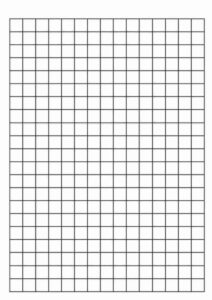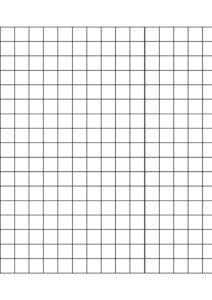Centimeter grid paper is an indispensable tool in various fields, especially in precision engineering and design. Its use extends from sketching and drafting to mathematical calculations and architectural drawings. In this comprehensive SEO guide, we will delve into the significance of centimeter grid paper, its applications, benefits, and tips for effective utilization.
1 Centimeter Grid Paper Template:
Centimeter grid paper, also known as graph paper, is a type of paper with a grid pattern consisting of evenly spaced horizontal and vertical lines. Each square on the grid represents a specific unit of measurement, typically centimeters or millimeters. The grid lines are printed in a light color to ensure they do not overpower the content drawn or written on the paper.
Applications of Printable Centimeter Grid Paper:
Engineering Drawings:
Engineers use centimeter grid paper for precise technical drawings, such as blueprints, schematics, and mechanical designs. The grid provides a structured framework for accurately plotting dimensions, angles, and shapes.
Architectural Drafting:
Architects rely on grid paper for drafting building plans, floor layouts, and elevation designs. The grid aids in maintaining proportional scales and spatial relationships within the architectural drawings.
Mathematics and Geometry:
Students and professionals in mathematics and geometry use centimeter grid paper for graphing equations, plotting geometric shapes, and conducting mathematical calculations. The grid serves as a visual aid for understanding mathematical concepts.
Art and Design:
Artists and designers utilize centimeter graph paper for sketching, doodling, and creating intricate patterns. The grid structure assists in maintaining symmetry, perspective, and proportions in artistic compositions.
Crafting and DIY Projects:
Hobbyists and DIY enthusiasts find centimeter grid paper useful for planning and executing projects such as quilting, knitting, and woodworking. The grid helps in measuring materials accurately and aligning components precisely.
Benefits of Using 1 Centimeter Grid Paper
Precision and Accuracy:
The primary advantage of centimeter grid paper is its ability to facilitate precise and accurate measurements. The grid lines provide a reference framework for ensuring consistency and correctness in drawings, calculations, and designs.
Clarity and organization:
The grid pattern enhances the clarity and organization of the information presented in the paper. It helps in distinguishing between different elements, aligning objects neatly, and maintaining a professional appearance in documents.
Scale and proportion:
Centimeter graph paper allows users to work to scale, meaning they can represent larger objects or areas in a reduced format while preserving accurate proportions. This is crucial in fields such as engineering and architecture where scale drawings are essential.
Visualization and Planning:
The visual nature of the grid aids in visualizing concepts, brainstorming ideas, and planning layouts effectively. It enables users to sketch rough drafts, make revisions, and refine designs before finalizing them.
Versatility and accessibility:
Centimeter graph paper is versatile and readily available in various formats, including notebooks, pads, and printable sheets. It can be used in combination with other tools such as rulers, compasses, and templates to enhance productivity and creativity.
Tips for Effective Use of Centimeter Grid Paper Templates
Choose the Right Grid Size:
Select centimeter grid paper with an appropriate grid size based on the level of detail and precision required for your task. Smaller grids (e.g., 1 cm squares) are suitable for intricate drawings, while larger grids (e.g., 5 cm squares) are ideal for rough sketches and diagrams.
Use Quality Paper:
Opt for high-quality centimeter grid paper that is durable, smooth, and resistant to ink bleeding or smudging. This ensures a clean and professional finish in your drawings and documents.
Employ Proper Drawing Tools:
Use fine-tipped pens, mechanical pencils, or drawing instruments like rulers and protractors when working on centimeter grid paper. This helps in creating crisp lines, accurate angles, and precise measurements.
Label and Annotate:
Label key points, dimensions, and annotations on your centimeter grid paper to provide context and clarity to your work. Clear labeling enhances comprehension and communication, especially in technical drawings and diagrams.
Practice Grid-Based Exercises:
Engage in grid-based exercises such as grid scaling, symmetry drawing, and isometric sketching to improve your proficiency in using centimeter grid paper. Regular practice hones your spatial awareness and drawing skills.
Conclusion
In conclusion, 1 centimeter grid paper is a versatile and essential tool for professionals, students, and enthusiasts across various disciplines. Its precision, clarity, and versatility make it indispensable for tasks ranging from engineering drawings to artistic creations. By understanding its applications, benefits, and tips for effective use, individuals can harness the full potential of centimeter grid paper in their endeavors.
![Free Printable Graph Paper Online [PDF Download] ✅ ❤️](https://igraphpaper.com/wordpress/wp-content/uploads/2024/04/igraphpaper-logo.png)




